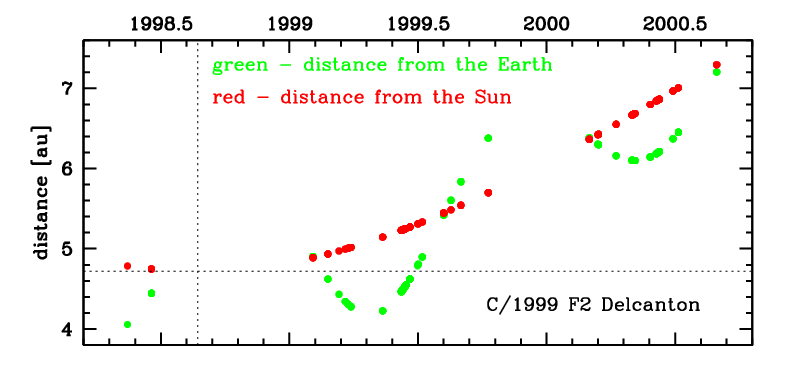C/1999 F2 Delcanton
more info
C/1999 F2 was discovered on 20 March 1999 by J. Delcanton in the Sloan Digital Sky Survey as an apparently cometary object, seven months after perihelion passage. Soon after, Gareth V. Williams found pre-discovery measurements in archival LINEAR data going back to 18 June 1998 [IAUC 7194, 1999 June 8]. Later, the pre-discovery detection from 15 May 1998 taken by Two Micron All Sky Survey (2MASS) was found.
This comet made its closest approach to the Earth on 14 April 1998 (3.923 au), about four months before perihelion.
Solution given here is based on data spanning over 2.3 yr in a range of heliocentric distances: 4.79 au – 4.719 au (perihelion) – 7.30 au.
This Oort spike comet suffers moderate planetary perturbations during its passage through the planetary system that lead to notable more tight future orbit (see future barycentric orbit).
See also Królikowska 2014 and Królikowska and Dybczyński 2017.
This comet made its closest approach to the Earth on 14 April 1998 (3.923 au), about four months before perihelion.
Solution given here is based on data spanning over 2.3 yr in a range of heliocentric distances: 4.79 au – 4.719 au (perihelion) – 7.30 au.
This Oort spike comet suffers moderate planetary perturbations during its passage through the planetary system that lead to notable more tight future orbit (see future barycentric orbit).
See also Królikowska 2014 and Królikowska and Dybczyński 2017.
| solution description | ||
|---|---|---|
| number of observations | 148 | |
| data interval | 1998 05 15 – 2000 08 29 | |
| data type | significantly more measurements after perihelion (POST+) | |
| data arc selection | entire data set (STD) | |
| range of heliocentric distances | 4.79 au – 4.72 au (perihelion) – 7.3 au | |
| detectability of NG effects in the comet's motion | NG effects not determinable | |
| type of model of motion | GR - gravitational orbit | |
| data weighting | YES | |
| number of residuals | 293 | |
| RMS [arcseconds] | 0.73 | |
| orbit quality class | 1a | |
| orbital elements (heliocentric ecliptic J2000) | ||
|---|---|---|
| Epoch | 1998 08 15 | |
| perihelion date | 1998 08 23.98827200 | ± 0.00257200 |
| perihelion distance [au] | 4.71880860 | ± 0.00001514 |
| eccentricity | 0.99863745 | ± 0.00001566 |
| argument of perihelion [°] | 352.393463 | ± 0.000353 |
| ascending node [°] | 210.295764 | ± 0.000051 |
| inclination [°] | 56.421004 | ± 0.000049 |
| reciprocal semi-major axis [10-6 au-1] | 288.75 | ± 3.32 |
